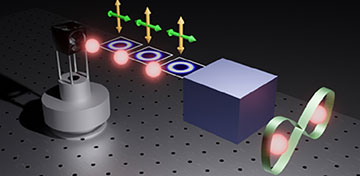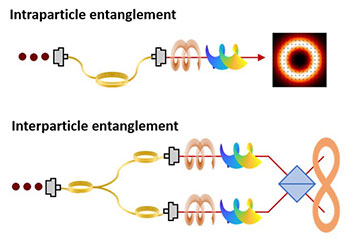
The flexible platform reported in the latest study exploits a quantum-dot source of single photons to generate entangled pairs of photons that carry orbital angular momentum. [Image: Nicolò Spagnolo]
Researchers in Italy and France have demonstrated a photonics platform for generating the complex quantum states that are needed to enable more information to be encoded into a single photon (Adv. Photon., doi: 10.1117/1.AP.5.4.046008). The high-dimensional quantum states were created by combining a single-photon source based on quantum dots with devices that couple together the photons’ polarization and orbital angular momentum (OAM), providing a nearly deterministic source of bright single photons that can be entangled in the hybrid space composed of polarization and OAM.
Taking advantage of OAM
Single photons are widely exploited as qubits that can exist in a superposition of two quantum states, but more information can be encoded into photons with OAM because they can access more quantum states at the same time. Photons in these high-dimension quantum states could support enhanced security protocols in communications networks and offer a route to producing more powerful quantum computers. But so far, it has proved difficult to create a deterministic source of single photons that carry OAM.
Conceptual scheme of the proposed protocol. Intraparticle entangled states are generated by making the polarization and OAM of single photons interact through a q-plate. In the interparticle regime, two photons characterized by specific states in the hybrid space composed of polarization and OAM interfere using a beam-splitter. [Image: Alessia Suprano] [Enlarge image]
One key element of the new platform is a single-photon source based on semiconductor quantum dots, which can generate indistinguishable single photons with high brightness in a nearly deterministic way. A device called a q-plate, which can adjust the OAM of the photon based on its polarization, is then used to join these two forms of angular momentum, yielding a special class of quantum states that are called vector vortices.
These vector vortices are known to support entanglement between the multiple quantum states within the particle, which enabled the researchers to generate pure single photons that are entangled within the hybrid OAM–polarization space. The formation of these states can also be directly validated through single-photon counts, avoiding the need for an additional heralding process that can slow down the generation of high-dimensional photonic states.
“A step forward”
The researchers were also able to use the platform to implement a two-photon quantum gate, creating pairs of entangled photons within the hybrid OAM–polarization space.
“The proposed scheme represents a step forward in high-dimensional multiphoton experiments, and it could provide an important platform for both fundamental investigations of quantum states and for quantum photonic applications,” commented lead author Fabio Sciarrino, head of the Quantum Information Lab at the Sapienza University of Rome, Italy.

